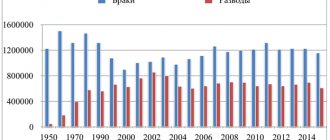All-Russian Day of Family, Love and Fidelity
Every year on July 8, an important Russian holiday is celebrated - the Day of Family, Love and Fidelity.
. It is symbolic that it was first celebrated in 2008, which was declared the Year of the Family in Russia.
This holiday was established on the initiative of deputies of the State Duma of the Russian Federation, which was supported by all traditional religious organizations of Russia - after all, the idea of celebrating the Day of Family, Love and Fidelity has no denominational boundaries
. Every religion has examples of family fidelity and love.
The idea of the holiday arose among residents of the city of Murom (Vladimir region), where the relics of the holy spouses Peter and Fevronia, patrons of Christian marriage, are buried, whose memory is celebrated on July 8.
The life of Peter and Fevronia embodies the traits that the traditional religions of Russia have always associated with the ideal of marriage, namely: piety, mutual love and fidelity, performing acts of mercy and caring for the various needs of their fellow citizens.
But the family is also a very important social unit that is protected by law. In Article 38 of the Constitution of the Russian Federation
it is clearly stated that:
1. Motherhood and childhood, the family are under the protection of the state.
2. Caring for children and raising them is an equal right and responsibility of parents.
3. Able-bodied children who have reached the age of 18 must take care of disabled parents.
The family holiday has a commemorative medal “For Love and Fidelity,” which is awarded on July 8, and a very gentle symbol - the chamomile, because this wild flower has been considered a symbol of love in Rus' since ancient times.
The symbol of the holiday is chamomile, because this wild flower has been considered a symbol of love in Rus' since ancient times (Photo: Iakov Kalinin, Shutterstock)
Every year, the Day of Family, Love and Fidelity is becoming more and more popular. In many Russian cities, local authorities and public organizations hold various festive and special events - congratulatory concerts, various exhibitions and competitions, honoring large families, spouses who have lived together for more than 25 years, charity events, etc. By the way, young people have a belief that a marriage concluded on July 8 will be long and happy.
The main events of the Day of Family, Love and Fidelity traditionally take place in the historical homeland of the holiday - in the city of Murom. Theatrical performances, reconstructions of scenes from the biography of Saints Peter and Fevronia, and master classes on rare crafts are organized here. Guests and residents of the city visit fairs, attractions, and participate in animation programs. Pilgrims visit holy places and venerate the relics of Murom miracle workers, begging them for help in finding their other half, or for harmony in families, respect and mutual understanding.
It has also become traditional to hold an awareness-raising campaign “Give Me Life!” in many Russian cities and regions, dedicated to this holiday, which is aimed at reducing the number of abortions in Russia and preserving family values. All events are widely covered by the media.
And, of course, today’s date is a wonderful occasion to get together with the whole family and show special care for your family and friends. After all, this warm holiday is welcome in any home, which is why it is so easy for him to walk - having come out of the church calendar, he is ready to knock on every door.
Let us remind you that International Day of Families is celebrated annually on May 15th.
The history of the holiday: Saints Peter and Fevronia
The holiday is based on the story of love, life and even death of the Prince and Princess of Murom - Peter and Fevronia. For a long time, the life of the couple was not studied by church representatives. Only in the last 20 years have they begun to collect materials about spouses to see what adversities they had to overcome.
Scientists take most of the information from chronicles and legends. We will not describe in detail the biography of the heroes; we will only tell the facts that are considered confirmed.
The Legend of Peter and Fevronia
Peter is the heir to the Murom principality, Fevronia is the daughter of a poison dart frog who practiced medicine, for which some in her native village called her a witch. According to legend, the prince became terminally ill and sent his subjects in search of a doctor. They found Fevronia, who cured him, and the man asked for her hand in marriage.
During their life together, the couple experienced many hardships: expulsion from their hometown, the unfriendly attitude of the boyars due to the wife’s humble origins. But the heroes coped with the difficulties.
However, after many years of marriage, both man and woman decided to enter monasteries. Perhaps the death of their eldest son prompted them to make a decision, but this version has not been confirmed. Since after tonsure the husband and wife were in different monasteries, they exchanged letters. Their earthly love became a spiritual affection.
A year later, the couple died. The causes of death are given differently, but all sources write that it happened on the same day. Further in the chronicles they talk about a miracle: the bodies of the couple, placed in different coffins for burial, ended up in one. After a miraculous reunion, they began to be considered patrons of Murom and revered as saints.
Over the following centuries, spouses were considered patrons not of the family, but of the Aryan family. At various times, kings came to the relics of Peter and Fevronia to ask for help in state affairs, less often for health, the birth of children, or with personal requests.
The plot of the "Tale"
According to legend, Prince Peter saved his brother's wife from a fiery serpent, killing him with the help of Agrikov's sword. The splashes of snake blood that fell on the prince caused a severe skin disease, causing Peter's body to become covered with ulcers.
A servant sent in search of a doctor met in the Ryazan village of Laskovo the peasant woman Fevronia, the daughter of a “drevolaz” (wild honey collector). She agreed to heal Peter in exchange for a promise of marriage. However, after healing, the prince refused to marry a commoner. A short time later, the illness resumed because Fevronia deliberately did not heal one of the ulcers on the prince’s body. He again turned to the girl for help and, after recovery, fulfilled his promise to marry her.
The boyars did not recognize the princess and demanded that Peter expel her from Murom. Fevronia agreed to leave, but on one condition: she would take with her what she wanted. As a result, the princess took her husband with her. In Murom, a struggle for power began, which led to unrest. At the request of the boyars, the princely couple returned to the throne and ruled Murom until their death.
In old age, Peter and Fevronia took monastic vows with the names David and Euphrosyne. They died on the same day - July 8 (June 25), 1228. While still alive, the couple asked to be buried together, but “foolish people” placed the bodies of the deceased in different monasteries. The next day they were found in the same coffin, after which the princely couple was buried together, as they had requested.
Establishment of the holiday
The tradition of celebrating the day of Peter and Fevronia arose in Murom back in the 1990s, but the holiday was celebrated unofficially. In 2006, at the initiative of the city administration, a collection of signatures was carried out in support of the establishment of Family Day in the Russian Federation. The proposal was supported by about 20 thousand citizens.
In January 2008, declared the Year of the Family in Russia, the head of the Accounts Chamber, honorary citizen of Murom Sergei Stepashin, the mayor of Murom Valentin Kachevan, the rector of the Transfiguration Monastery, Abbot Kirill, and others signed a communique on the establishment of the All-Russian Day of Married Love and Family Happiness. This initiative was approved by the Russian Federation Council Committee on Social Policy, as well as religious and public organizations and Russian regions.
For the first time, the holiday, called the Day of Family, Love and Fidelity, was held in July 2008. It was organized by the Foundation for Social and Cultural Initiatives, headed by the wife of the Prime Minister of the Russian Federation, Svetlana Medvedeva. The symbol of the day is the chamomile flower.
Appreciate happiness! It is born in the family!
Poems for Happy Family Day, short and beautiful
***
Love it! And appreciate happiness! It is born in a family, What could be more precious than it On this fabulous land!
***
The words “family, love and fidelity” carry a huge meaning. Where there is family, there is always tenderness, Where there is love, they are always waiting for us.
***
Family is a fortress, family is a home. It should be a cozy nest for you! The bliss of comfort and the babbling of children is more expensive than any of the most delicious sweets!
Love each other, love your home, Love the family that is in it. Appreciate your loved ones, respect, cherish, Warm each other with the warmth of your hands!
***
If you take Love and loyalty, Add to them the Feeling of tenderness, Multiply everything by years, You get - Family!
***
Family is your fortress, which was built together, Family is a place where souls are not stuffy, Family is disputes, then reconciliation, Family is anxiety and worry for each other
And there is a common joy for everyone, but a big one, Sadness, on the contrary, is broken into crumbs, And the main thing is love and care, And loyalty, and flying to the stars, hugging each other.
***
The first value in Russia is family! The hearth of the house warms us, always loving us. My relatives will join hands, You won’t find a friendlier family in the world. Joy and laughter surround us all, and together we will certainly succeed.
***
Loyalty, love and smiles of hearts. Every father dreams of this! Every mother protects peace! Guys, appreciate it, you have been given happiness - Every family, of course, has it!
***
Family is the basis of every life, Love is the basis of all foundations, And loyalty is above all whims, All together - better than any dreams! Let love and fidelity and family live in every home! After all, everyone in the world knows for sure that only the house will save me!
***
Family is a blessing given to us from above, because life cannot be lived without love. Love is the holy joy of our life, And fidelity will help preserve it.
In family life, the most important screw is love. Chekhov A.P.
The history of the origin of the holiday - why July 8th?
The Day of Family, Love and Fidelity is timed to coincide with the Orthodox holiday: on July 8, the Russian Orthodox Church celebrates the day of remembrance of Saints Peter and Fevronia. However, this date has long gone beyond the Orthodox calendar and the first to advocate the emergence of a new holiday were residents of the city of Murom, Vladimir Region.
The date has been celebrated in Murom, the small homeland of Prince Peter and his wife Fevronia, since the 1990s. Only a few years passed and the holiday grew into a citywide one. In the early 2000s, the celebration of the city day was moved to July 8 (the date of death of the spouses). In Murom, mass celebrations, concerts, public events began to be held, and exhibitions of handicrafts were organized.
In 2006, the residents of Murom decided to immortalize their heroes and collected about 20,000 signatures with a request to declare the day of memory of the princes an all-Russian holiday. The figure is impressive: in Murom itself, according to official data, 109,000 people live. The initiative was supported by regional authorities, the State Duma, the Federation Council and the Russian Orthodox Church.
Who are Peter and Fevronia?
Since 2008, the Day of Family, Love and Fidelity has been celebrated throughout Russia, but few people remember the history of the saints. We invite you to mentally travel back to 1203, when the noble prince ascended the throne in Murom. Several years before this event, he fell ill with leprosy. The medicine of those years could not boast of advanced achievements and technologies, so no one in the principality was able to heal the ruler. You could only rely on your own immunity and luck.
Such a case also happened to Peter - one day he dreamed that Fevronia, the daughter of a “tree climber” (the girl’s father extracted wild honey) from the village of Laskovo near Ryazan, could cure him. According to legend, the forest inhabitants listened to her and she knew about the properties of medicinal herbs. After healing, the prince married a pious healer. And everything would be fine, but the newlyweds were not at all suitable for each other in terms of social status. The boyars did not accept the union of the prince and the commoner. The couple decided to flee Murom along the Oka River, give up all privileges and live a simple and peaceful life.
Alas, this did not last long. Fights for the throne began in the principality and turmoil reigned. Residents of Murom asked Peter and Fevronia to return. The prince and princess agreed, and for good reason - during the years of their reign they gained people's love. At the end of their lives, the couple took monastic vows with the names David and Euphrosyne and died in different monasteries on June 25 (July 8, new style) 1228. By the will of the deceased, their bodies rest in a common coffin with a thin partition.
Canonization of saints
Image: .
Now the relics of the saints are in the Holy Trinity Convent (Murom). Almost three centuries later, in 1547, the couple was canonized by the church. Many rulers came to venerate the relics of Peter and Fevronia: Peter I, Catherine II, Nicholas I, Alexander II.
The story of the noble princes was reflected in ancient Russian literature - everyone knows “The Tale of Peter and Fevronia”. Academician Sergei Likhachev called the relationship between the characters a “union of love” and a “wise marriage.” However, there were also experts who did not accept this couple. The fact is that, according to legend, after the healing Peter deceived the girl and did not want to get married. The marriage was concluded only after the illness returned and Fevronia helped Peter for the second time.
In addition, judging by historical documents, the couple did not have children. Opponents of veneration of the faithful are confident that such a union cannot fully be a model for a Christian couple. They even cite as an example Cyril and Maria of Radonezh, who were a couple with many children and did not encounter all sorts of misadventures along the way.
Do not overshadow family holidays by worrying about your child - always know where he is and what is happening in his environment. For example, when you go to a mass event. Download the “Where are my children” application from the AppStore and GooglePlay.
Peter and Fevronia Day: what kind of holiday is this and what does daisies have to do with it
The Day of Remembrance of Saints Peter and Fevronia or the Day of Family, Love and Fidelity is considered Russian Valentine's Day and is celebrated on July 8 in 40 countries around the world. Why exactly these saints became a symbol of marital happiness and what do daisies have to do with it, TV Center will tell you.
A temple is being built in Moscow in honor of Peter and Fevronia
According to legend, the son of the Murom prince Peter, after a battle with the serpent, was infected with its poisonous blood and suffered from a terrible disease - the whole body of the noble young man was covered with terrible ulcers. In search of a cure, Peter learned that the beekeeper's daughter Fevronia could help him.
The future prince went to the girl in Ryazan land to ask for help, but she promised to heal him in exchange for marriage. Peter agreed to the beauty’s conditions, and she relieved him of the ulcers, but not completely - the girl decided to leave one, the most inconspicuous one, until the wedding. But the young man changed his mind and refused an unequal marriage with a commoner. Soon the illness returned, and he was again forced to turn to Fevronia. The girl cured the young man for the second time, and then they got married.
The Murom boyars did not like the beautiful and intelligent commoner, and they demanded that Peter leave his wife or give up power when his time to rule came. Peter decided to stay with his wife and left the city. Soon after this, unrest began in Murom, and the repentant boyars called the young prince back.
Peter and Fevronia ruled for a long time and lived happily, and with the advent of old age they decided to leave the throne and take monasticism. They took the names David and Euphrosyne and settled in different monasteries. Before death, the lovers prayed to God to allow them to die on the same day and hour and to walk hand in hand after death. And so it happened. In the last minutes of his life, David ordered to warn Euphrosyne about his impending death. The messenger found her in her cell doing embroidery. The woman carefully folded her needlework, lay down and died quietly at the same time as her husband. This happened on June 25 (July 8), 1228.
But, instead of burying the couple in a pre-prepared double coffin, the monks decided to bury them separately on the territory of different monasteries. The next morning a miracle happened - the bodies of David and Euphrosyne were found in the same coffin. They tried to separate them several more times, but it was all in vain. So they were buried, in the Church of the Nativity of the Blessed Virgin Mary.
300 years after their death, Peter and Fevronia were canonized. And the day of their death became the Day of Family, Love and Fidelity. It is generally accepted that on this day young people should celebrate their engagement and exchange rings in order to become the bride and groom in the eyes of the whole world.
From ancient times, Peter and Fevronia were prayed for to preserve the family, strengthen feelings and well-being, they were asked to give health to their relatives and a successful marriage. Not only those who are already married or just looking for love, but also those whose family can only be saved by a miracle, hoped for the help of the saints.
People also believed that on July 8, mermaids swim into shallow waters and have fun there. To appease the river maidens, you had to buy a scarlet ribbon and throw it into the river, saying: “Beauty from the underwater kingdom, accept this gift, just don’t touch adults or children.”
On the holiday, the feast consisted of simple Lenten dishes, and the ancestors of the family, the oldest married couple, were seated at the head of the table. Housewives baked large pies for this day, which had to be divided among all family members - it was impossible to share with strangers. The crumbs were not thrown away, but given to poultry.
On July 8, girls and married women collected daisies and dried them, and then added them to tea, which they then drank with their lover to strengthen feelings. They rinsed their hair with a decoction of chamomile to give it shine.
Also, amulets were made from chamomile flowers, which received special life-giving power on this day. It was necessary to sew a small bag from red cloth, collect daisy and cornflower petals in it, which symbolize love and fidelity. At the same time, you need to say the words of the conspiracy: “Flowers of the field, as you bloom and smell fragrant, so let our love bloom, so that we live with this feeling and do not grieve about anything. We will have children and grandchildren, we will live in love, knowing neither torment nor boredom. Amen". After this, the bag should be tied with a scarlet ribbon - and the love amulet is ready.
Chamomile still remains one of the symbols of Family Day, love and fidelity.
Nowadays, lovers give each other Fevronkas for the holiday - postcards made in the shape of daisies, in which they confess their feelings. All the most interesting things are in our Yandex.Zen channel. Even more news is in our Telegram
Family or Love Day? What is the difference between the dates February 14, July 8 and May 15
Now there are three “days of love” on the calendar: July 8, February 14 and May 15. The Day of Family, Love and Fidelity has not escaped comparison with Valentine's Day. Here, too, there is a historical background and forbidden love that breaks through all barriers. The Western holiday quickly became fashionable in the CIS countries, which pleased not only lovers, but also marketers. On February 14, people massively buy Valentine's cards and other symbols of the holiday to give to their loved ones. Moreover, this day is celebrated not only by married couples, but also by those who have just started dating.
And if you are against church holidays and other people’s love stories, then you can choose May 15 for yourself - this is International Family Day . It was established by the General Assembly of the United Nations in 1993. On this day, various events are held all over the world, round tables are held where measures to support social units are discussed, and awards are presented. In Russia, this holiday also acquired socio-political significance, but it did not become a red day on the calendar for the families themselves.
Holiday symbol
The Day of Family, Love and Fidelity has its own symbol – the daisy. The flower was not chosen by chance. Briefly about what chamomile means in the language of flowers:
- Chamomile symbolizes kind, gentle and humble love. Unlike the rose, it is not as passionate and compromising.
- The flower can heal many diseases.
- This is a symbol of innocence and sincerity, romantic dreams.
- Chamomile is one of the most popular wild flowers and grows in all corners of Russia.










